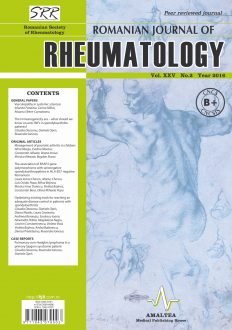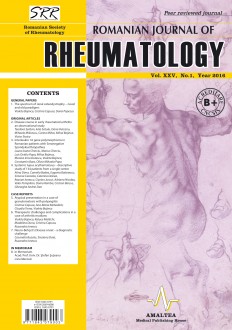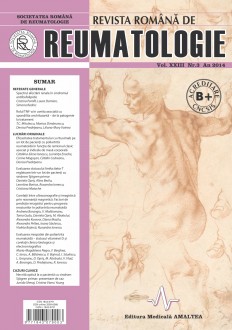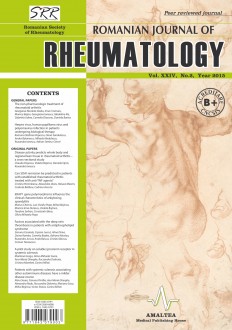SELECT ISSUE

Indexed

| |

|
|
|
| |
|
|
|

|
|
|
|
|
|
| |
|
|
HIGHLIGHTS
National Awards “Science and Research”
NEW! RJR has announced the annually National Award for "Science and Research" for the best scientific articles published throughout the year in the official journal.
Read the Recommendations for the Conduct, Reporting, Editing, and Publication of Scholarly work in Medical Journals.
The published medical research literature is a global public good. Medical journal editors have a social responsibility to promote global health by publishing, whenever possible, research that furthers health worldwide.
OPTIMIZING EXISTING TOOLS FOR REACHING AN ADEQUATE DISEASE CONTROL IN PATIENTS WITH SPONDYLOARTHRITIS
Claudia Deaconu, Daniela Opris, Diana Mazilu, Laura Groseanu, Andreea Borangiu, Saulescu Ioana, Alexandra Peltea, Magdalena Negru, Cosmin Constantinescu, Violeta Vlad, Violeta Bojinca, Andra Balanescu, Denisa Predeteanu and Ruxandra Ionescu
ABSTRACT
Background/Objective. Disease activity in spondyloarthritis (SpA) is evaluated through conventional scores such as BASDAI or ASDAS. The aim of this study was to determine disease activity in SpA patients under biological therapy with further assessment on the quality of each activity indicator and their clinical value together with their impact on NSAID intake.
Materials and methods. Over nine months (January–August 2015) we enrolled 100 patients with SpA on anti-TNF therapy (33% IFX; 35% ADL; 32% ETA). We collected demographic, clinical (BASDAI, ASDAS, PtGA) and laboratory data (ESR, CRP). Frequency of NSAID ingestion expressed as days per week was included in a questionnaire. Considering their biologic treatment, patients were divided into disease activity groups and sample characteristics were correlated and compared. Statistical analysis was performed with SPSS 20.0, using specific tests such as Pearson, Spearman or ANOVA.
Results. Patients with active disease, stated by both activity scores had an increased NSAID intake. Out of 86% of patients with a BASDAI under 4, only 82.6% had an ASDAS-CRP lower than 1.3. BASDAI correlated to both ASDAS scores (r = 0.65 and 0.71, P<0.001) and PtGA correlated to both disease activity scales, with a stronger correlation to BASDAI (r = 0.912, P<0.01) than ASDAS (r = 0.67 and 0.71, P<0.01 for both).
Conclusion. We proved that disease activity scores have good discriminatory power, with a strong correlation between the subjective BASDAI and PtGA. However, ASDAS-CRP proves to be more rigorous than other variables when targeting high and low disease activity, thus indicating the need of an objective component in assessing these patients.
Keywords: spondyloarthritis, disease activity scores, discriminatory power, anti-TNF therapy



